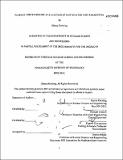| dc.contributor.advisor | Michael Driscoll. | en_US |
| dc.contributor.author | Kersting, Alyssa (Alyssa Rae) | en_US |
| dc.contributor.other | Massachusetts Institute of Technology. Dept. of Nuclear Science and Engineering. | en_US |
| dc.date.accessioned | 2013-02-14T15:19:41Z | |
| dc.date.available | 2013-02-14T15:19:41Z | |
| dc.date.copyright | 2011 | en_US |
| dc.date.issued | 2011 | en_US |
| dc.identifier.uri | http://hdl.handle.net/1721.1/76938 | |
| dc.description | Thesis (S.B.)--Massachusetts Institute of Technology, Dept. of Nuclear Science and Engineering, 2011. | en_US |
| dc.description | Cataloged from PDF version of thesis. | en_US |
| dc.description | Includes bibliographical references (p. 39). | en_US |
| dc.description.abstract | The limiting factor in current designs for fast reactors is not only the reactivity, but also the maximum permissible fast-neutron fluence in the cladding, especially for reduced uranium enrichment cores using high-albedo MgO reflectors. The intent of this thesis was to determine the best design parameters - fuel type, fuel compound, fuel arrangement, and coolant - while observing these limitations. The ERANOS code was used to determine the flux values for each design option. A curve was fitted to the fluxes taken at beginning of life, middle of life, and end of life. This curve was then integrated progressively until the clad fluence limit of 4 x 1023 fast neutrons/cm 2 was reached. The different design options were compared with emphasis on minimizing enrichment and maximizing burnup. Sodium was chosen as a coolant because of its extensive experience based compared to the other options, as well as its heat transfer properties. Inverted fuel was found to be better neutronically, in both clad lifetime and burnup than conventional pin-type fuel, but the requirement of fuel venting may discourage use of this option. Uranium carbide was found to be superior to nitride, oxide or metal fuel in its clad lifetime, especially if pin cell fuel is used. If inverted fuel is used, uranium oxide is also a valid choice from a burnup and cost perspective, especially should re-cladding not be feasible or desired, since the reactivity and clad fluence lifetimes of oxide fuel are similar to each other. | en_US |
| dc.description.statementofresponsibility | by Alyssa Kersting. | en_US |
| dc.format.extent | 39 p. | en_US |
| dc.language.iso | eng | en_US |
| dc.publisher | Massachusetts Institute of Technology | en_US |
| dc.rights | M.I.T. theses are protected by
copyright. They may be viewed from this source for any purpose, but
reproduction or distribution in any format is prohibited without written
permission. See provided URL for inquiries about permission. | en_US |
| dc.rights.uri | http://dspace.mit.edu/handle/1721.1/7582 | en_US |
| dc.subject | Nuclear Science and Engineering. | en_US |
| dc.title | Fluence-limited burnup as a function of fast reactor core parameters | en_US |
| dc.type | Thesis | en_US |
| dc.description.degree | S.B. | en_US |
| dc.contributor.department | Massachusetts Institute of Technology. Department of Nuclear Science and Engineering | |
| dc.identifier.oclc | 824556798 | en_US |
